Lijiang, Yunnan Province
Concrete and glass high-rise banks and hotels winked at the neighboring Jade Dragon Mountains as if to signal, “Just another plane-load of tourists high-tailing it to Old Town to savor its 750-year-old ‘mystery and authenticity.'”
Our China Yunnan Air flight bulged with tourists from Shanghai to Macao. If we had driven overland the distance from Kunming west to Dali, then north to Lijiang, it would have cost us a grueling 372 miles.
After a forty-five minute flight, and half an hour driving time from the airport, our driver easily negotiated Lijiang’s expansive Shangri-la Boulevard past the spanking new city emerged from the ashes of a 1996 earthquake.
Many Chinese tourists come to soak in the tranquility and fresh air of Lijiang’s mountain setting, to familiarize themselves with the local ethnic groups, particularly the Naxi and its Dongba written language, but they also come for the medicinal herbs, one of Lijiang’s top commodities along with copper, jade and cedar wood.
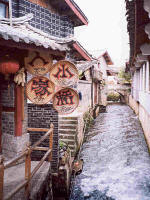

Lijiang canal
![]()
![]()
When the driver parked at the Ancient Water Wheel where the asphalt ended and the pedestrian-only walkways of Old Town commenced, I thought he had made a wrong turn and ended up in Gruyere, Switzerland. Groups of tourists took photos of one another in front of the water wheel being sure to include the quaint bridges, the gurgling canal and the potted mums.
We hadn’t expected to find James Hilton’s Shangri-la, having been forewarned that the town, although distant from the usual Western tourist circuit, was certainly not terra incognita. Both the Fort Lauderdale Sun-Sentinel (“A Distant Harmony June 24’01 and July 07’01 by Yinjie Qian) and the New York Times featured Lijiang this past year. Three years earlier, a Chinese in-flight magazine article had piqued our interest in this land of ice and snow spirits where Hilton once visited American botanist Joseph Rock.
Webster’s dictionary described Shangri-la as a “remote, idyllic hideaway”. Lijiang, a UNESCO World Heritage Site, could neither be called remote nor a hideaway, but I was eager to explore this warren of stone walkways flanked by partly medieval and partly white-washed brick and slate-roofed townhouses that teetered over narrow canals. On closer scrutiny, we definitely weren’t in Gruyere.
No mistaking the graceful pitch of the Chinese rooftops whose corners curled delicately upward to salute the heavens, discouraging bad spirits from alighting. To enter these houses or shops, one normally had to step up and over the threshold or cross a wood plank straddling the canal. And also, unlike Switzerland, one discovered that the real garden remained behind closed doors, in the lush courtyards, sheltered from the elements and the curious. “So, when do we get to see Shangri-la?” I facetiously asked Norman, our local guide, as he helped Chris and I settle into our lodging at the Ancient Town Inn. He smiled gently, “You know it’s a place in your own imagination.”
Over breakfast at the Color of the Wind, a “healing foods” restaurant, Norman set me straight. “The Shangri-la you’re talking about is a little bit farther…past Zhondian,” he explained. He was referring to the Mei Li Snow Mountains. He would be coming with us as our translator along with our Zhondian jeep driver, Mr. Zhang. Norman was not a native of this region. He hailed from Jiling province bordering Korea. Just like in the USA, young Chinese were traveling and going wherever their work took them.
Slight in build, with fine features and fair complexion, Norman brimmed with the enthusiasm and optimism of a new recruit. This would be his first trip beyond Lijiang to Zondian and finally to Deqin which touches the Tibetan Autonomous Province border.
“By the end of this trip, we’ll drive you crazy,” I warned Norman. “Americans ask a lot of questions. And we complain! Then we go home and tell everyone what a great trip we had.” He shook his head in mock disbelief. “Yes, yes, it’s true,” I insisted.
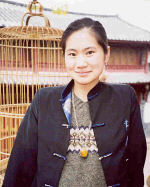

Bu Ning, proprietor of the Color of the Wind restaurant
![]()
![]()
The restaurant owner, Bu Ning, came out to help us with the menu. We were sitting out on the veranda overlooking the foot traffic. She shivered in the October air, pulling her jacket around her even though the sun was shining. Bu Ning invited us to visit the kitchen on the first floor where we could point to what we wanted to eat.
We tried a local specialty, the Lijiang bean curd soup. In spite of its grayish color, the soup had a soothing consistency like tapioca. Later in the day, we returned to try a spicy eggplant dish. We didn’t know if the dish cured any ailments but it pleased our palates immensely. While we ate, a waitress trainee practiced balancing a tray stacked with wineglasses – she stood as still as the Buddha statue perched on an antique wood buffet in the recesses of the second floor dining room.
A few steps away from Color of the Wind, an herbal pharmacy welcomed a steady flow of customers who perused the array of mushrooms and roots. Pharmacists stood by attentively to prescribe appropriate treatments. “We have many Japanese who come here for an unusual fungi (dong chong xia chao). It changes from a fungi into a caterpillar at one stage,” Norman explained.
Today was “Old Men’s Day” in Lijiang. A congregation of elderly Naxi men and women gathered in Sifang Square, forming two circles. They danced, moving as slowly as oil on water. The Naxi are the predominant ethnic group, although Lisu, Zhang, Mosu, Pumi, and Yi also live nearby. Much attention has been given to the shamans, a handful of elders who preserve the Dongba pictographic language, a language completely separate from Mandarin Chinese.
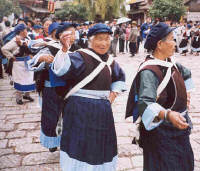

Naxi women dancing
![]()
![]()
The Naxi women’s distinctive dress, blue caps, aprons, and their decorative capes have also been noted and described by visitors. In “Getting to Know Dayan” (Lijiang Old Town), author Jim Goodman, describes the meaning of these unusual capes:
“The black-and-white seven starred capes symbolize the Burden of Heaven that Naxi women must bear. The colors represent night and day, the round patches the seven stars of the Big Dipper.”
Goodman’s description is part of the Old Town Map, “Roaming in Lijiang” which can be purchased at the Tourist Office just beyond the Old Water Wheel.
“For the Naxi, a fat woman is beautiful. The fatter you are, the better,” Norman said. I noted that the older women had round faces, rosy cheeks and their bodies looked solidly strong. The younger women (the few that I saw) were taller and thinner than their mothers and grandmothers. Perhaps Naxi women have the most beautiful smiles in the world I decided on the spot.
“But, Naxi women have very high voices!” Norman said. We walked past a music store from which the high-pitched trills of a Naxi folksinger emanated. To the untrained ear, the first notes resembled a cat whine, but, by the end of our trip, I yearned to hear more of this Naxi and neighboring Tibetan style of singing like rare birdsongs, reaching for the Everest peaks of a human vocal chord’s range.
In the multitude of old town shops, women stitched intricate patterns into silk ties, men carved wood panels or silver jewelry. Older women sold dried cranberries and roasted corn on street corners. As we crossed bridges to the residential part of Old Town, we peered into windows where women played cards. Others watched television in shops waiting for their lucky first customer. A young man with long hair brushed past us, his shoulder graced by a regally perched falcon.
Sifang Square, when not used for dances and festivals succumbed to the tourists with stands selling a variety of local souvenirs. Norman showed us how by lifting up one stone in the square, water from the nearby canal could be flooded across the expanse for cleaning. Cleanliness was important here. Each morning, the garbage truck drove through Old Town picking up garbage, while Naxi folk music spewing from its loudspeakers announced its arrival.
It didn’t take us long to get lost when we ventured out on our own, crossing and re-crossing the Old Bridge where students sketched the pleasing slant of rooftops.
On “Foreigner’s Street”, rows of cafes maximized the adjacent willow-draped canal by placing tables, chairs and wicker birdcages along its edge. As we walked past, I spotted a flash of blonde hair, and stopped to say “hello” to another ‘Gringo’. We had added this word to Norman’s travel guide vocabulary.
The ‘gringo’ turned out to be Alys Spensley, an American, visiting as a Fulbright research student. She was studying the impact of tourism on Lijiang. It helped that Alys spoke fluent Mandarin.
“So you’re going to Zhondian?”
“We’ve rented a jeep.”
“A jeep? You don’t need a jeep. Go by bus!” she jeered. I guess we weren’t REAL travelers going by jeep – but I had already heard rumors about the ‘roadwork’ going on. Our friend, Yinjie, who had traveled the previous year in a Toyota sedan had suggested the jeep.
A history teacher chatting with Alys reminded us to dress warmly. When we mentioned our plans to visit Zhondian’s lamasery, she said, “The monks will be eager to talk to you. They don’t see many Americans.”
Alys left us with one last bit of advice: “READ STILWELL” (“Vinegar Joe” Stilwell was assigned to China during World War II. Barbara Tuchman’s biography “Stilwell and the American Experience” tells it all.)
I could have happily sat at the Sakura Cafe for hours sipping espresso, munching on Naxi ‘baba’, a delicious fried bread, but we couldn’t stay in Lijiang for three days without paying tribute to some of its landmarks.
The Mu Mansion, once home to the Naxi Chieftain Mu, was a short walk from Foreigner’s Street. Although the World Bank reconstruction of Mu Mansion after the 1996 earthquake only ended three years ago, and the original Mu mansion had been destroyed in the 1870s, Chief Mu’s spirit seems ever-present.
The Mu Family’s rule of the Naxi people predated Kublai Khan’s invasion of the kingdom of Dali in the mid-thirteenth century. As the city grew and prospered, so did the influence of the Mu family. For twenty-two generations and 470 years, this family remained an integral force in Lijiang.
The mansion’s garden is just as important as its impressive complex of buildings and the sparkling white arch restored after its destruction doing the Cultural Revolution. Our ticket stub summarized the mansion’s symbolism to local people:
“the mansion is a garden for ancient Naxi Kingdom’s old trees and rare plants and mixes the freshness of nature and grandeur of royal palaces. The great mansion has the spirit of snow and ice water.”
I doubted that one visit could illuminate for us uninitiated newcomers “the deep myth of the Naxi ancient kingdom” which the ticket stub promised we might discover, but there was no doubt that the palace brimmed with powerful vibrations.
Unlike the rest of Lijiang, we walked alone across the vast expanse of stone walkways bordered by fragrant flowers and languid pools. Various buildings housed ancient Dongba and Dazang language manuscripts, famous calligraphy and paintings, statuary, and porcelain.
I caught the scent of orchids in passing a corner of the San Qing Taoist hall and marveled at how the mansion seemed the perfect microcosm of tranquility but also a self-imposed confinement from the teeming vitality of the town. In China, there seemed to be three separate realities – outside city life, inside temple life, and the wilderness. Gardens were good for putting the mind at ease and slowing the heartbeat, but I was eager to get back to Lijiang, our gateway to the wilderness.
Norman met us under Chief Mu’s arch decorated with the Naxi characters – “Let’s read”.
“Could you take us to the orphanage, Norman?”
“Yes, I had planned to,” he said.
There are two orphanages in Lijiang, both private institutions. I thought foreigners would be discouraged from visiting, but Norman assured us to the contrary. Foreigners were not only welcome but also worked as volunteer English teachers.
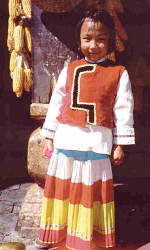

Child at the orphanage in minority clothing
![]()
![]()
We stepped through the main doors into a large stone courtyard just as the kids lined up for lunch. Nothing prepared us for the explosion of color – red chili peppers and yellow corn hung from wood beams. Red lanterns arched across the courtyard. Kids wore their yellow, white, red and blue, freshly-laundered traditional minority clothes. A kitten played hide-and-seek, hopping into one of the kid’s metal wash bowls. Sunlight washed the inner courtyard.
“You should see the courtyard at night when the lanterns are lit,” said Leslie Butterworth, an English volunteer. “It’s gorgeous!”
He and his wife, Vera, had been teaching English for the last few weeks. “We hate to leave. You get attached to these kids,” he explained. “It’s not anything like the state-run orphanages. We’ve seen one of those. Do you want some lunch?” Leslie asked as he walked out of the kitchen with a bowl of noodles. He tested a spoonful, then rolled to the ground, holding his hands to his stomach.
“You poisoned me, you poisoned me!,” he joked with the young chef, also a resident of the orphanage. Meanwhile the kids filed into a dining hall next to the front entrance.
“Not too many of the kids are here today because they’ve gone on an outing,” Leslie explained. Normally there’s forty-five – at the other orphanage, they have around two hundred-fifty.”
“Are the kids dressed in traditional clothes for a reason?” I asked.
“No, they wear their minority clothes every day. ‘Mama’ or Hu Man Li, the director doesn’t want them to forget who they are.”
“Do some of the kids get adopted?”
“No. None of these kids will be adopted. The boys learn a trade and some of the girls study nursing. Even the older girls who help out at the orphanage used to be residents.”
The Lijiang orphanage depends on volunteers and donations. The driving force is Hu Man Li who is said to invite beggar kids off the street if they have no home.
All of the bedrooms, kitchen and dining area encircle the central courtyard similar to our lodging at the Ancient Town Inn. Volunteers sleep at the orphanage – “We eat and sleep just like the kids. It’s very comfortable here,” Leslie assured us as Chris tried a bowl of the cook’s noodle soup.
After the kids finished lunch, they ran out to the courtyard to wash their hands and feet. One of the girls came up to practice her English, then shyly posed for a picture. We purchased a handmade purse and shoes which were being sold to support the orphanage.
Later in the evening, we attended a performance at the Dongba Palace to learn more about the Naxi shamans who have preserved their pictographic language. Some of the performances were translated into English, but we had already bought tickets for the Chinese show.
The interior of the Dongba Palace reminded me of Chiwong Gompa in Phaplu Nepal. For an outsider, it was hard to discern where Tibetan influence ended and Naxi tradition began. As the elderly musicians played ‘ba gua’ (music meant to accompany reading of scripture). The shaman or ‘Dongba’ opened the ceremony by blaring on two animal horns. I couldn’t help but think of the three day Mani Rimdu ritual which we had attended in 1998 in Phaplu. Mani Rimdu, unlike the Dongba performance, brought pilgrims and local people together for an event that they well understood: the classic reenactment of Good vanquishing Evil. I was surprised at the similarity between the Dongba spirit dance and the Tantric magicians’ vestments and dances we admired during Mani Rimdu.
However, tonight’s performance in Lijiang was meant for curious tourists, not an actual ceremony. In trying to make the Dongba culture accessible to outsiders, could its symbolism and magic survive from generation to generation? Or would it succumb to “folklorification”? Perhaps James Hilton had grasped the fragility of the magic threads that kept our beliefs – and illusions – intact.
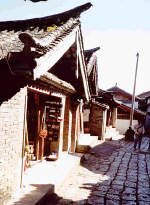

Lijiang street
![]()
![]()
We wandered back to our Ancient Town Inn lodging, shops still glowing brightly to entice the occasional evening straggler. Even an internet center operated inside one of the medieval townhouses.
In the morning, we’d begin the 125-mile drive to Zhondian, stopping at Tiger Leaping Gorge. The October morning air was cool and crisp and the sun continued to shine brightly.
“We are lucky!” Norman said as he greeted us. “Take a look. You won’t see this every day.” From the center of town, we could discern Jade Dragon Mountain’s jagged peak jutting into the blue sky.
Our driver, Mr. Zhang pulled up in a freshly washed Pajero Jeep. We were on our way – once again – in search of Shangri-la.